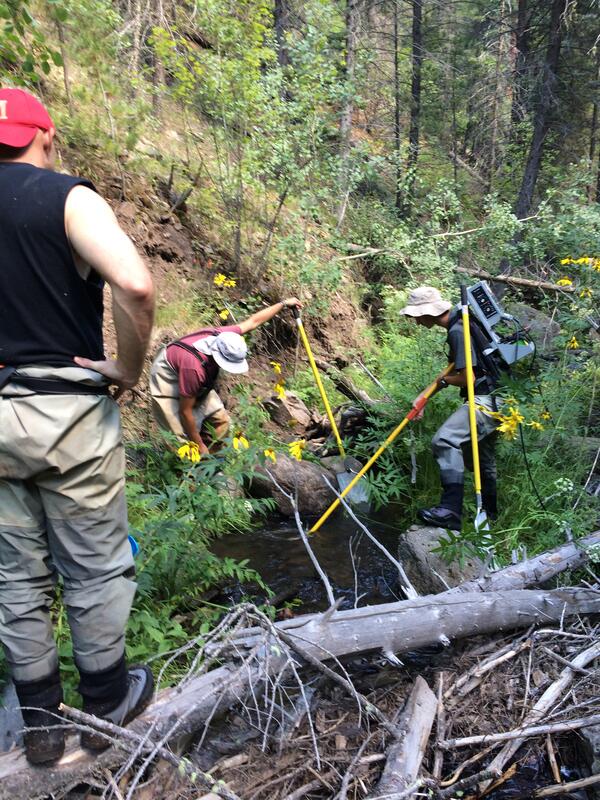Main Entrance to the Great Lakes Science Center's Headquarters building in Ann Arbor, MI.
Images
Explore our planet through photography and imagery, including climate change and water all the way back to the 1800s when the USGS was surveying the country by horse and buggy.
Main Entrance to the Great Lakes Science Center's Headquarters building in Ann Arbor, MI.

USGS employees take samples in Bronx River for a Northeast stream Quality Assessment
USGS employees take samples in Bronx River for a Northeast stream Quality Assessment
The end of Kaskawulsh Glacier lies at a drainage divide. Before spring 2016, the majority of the glacier's meltwater flowed north by way of the Slims River into Kluane Lake, and from there into the Yukon River and to the Bering Sea.
The end of Kaskawulsh Glacier lies at a drainage divide. Before spring 2016, the majority of the glacier's meltwater flowed north by way of the Slims River into Kluane Lake, and from there into the Yukon River and to the Bering Sea.

Landsat 8 satellite image of the Kaskawulsh Glacier in Canada's Yukon Territory, showing how glacier melt has altered meltwater discharge to the Kaskawulsh River.
Landsat 8 satellite image of the Kaskawulsh Glacier in Canada's Yukon Territory, showing how glacier melt has altered meltwater discharge to the Kaskawulsh River.
To investigate whether insects could be used as bioindicators of climate change, USGS researchers studied insect community composition along an elevation gradient in semi-arid shrublands of eastern Oregon.
To investigate whether insects could be used as bioindicators of climate change, USGS researchers studied insect community composition along an elevation gradient in semi-arid shrublands of eastern Oregon.

Brielle Heflin and Sarah Schoen catching forage fish with a cast net in Prince William Sound.
Brielle Heflin and Sarah Schoen catching forage fish with a cast net in Prince William Sound.
A banded Black-legged Kittiwake foraging near Little Green Island in Prince William Sound, Alaska.
A banded Black-legged Kittiwake foraging near Little Green Island in Prince William Sound, Alaska.
A banded Black-legged Kittiwake taking off with a juvenile Pacific herring near Little Green Island in Prince William Sound, Alaska.
A banded Black-legged Kittiwake taking off with a juvenile Pacific herring near Little Green Island in Prince William Sound, Alaska.
Increasing temperatures and decreasing precipitation threaten the persistence of the Rio Grande cutthroat trout, the southernmost subspecies of cutthroat trout, found only in parts of New Mexico and Colorado.
Increasing temperatures and decreasing precipitation threaten the persistence of the Rio Grande cutthroat trout, the southernmost subspecies of cutthroat trout, found only in parts of New Mexico and Colorado.

Black-legged Kittiwake captured 2 Pacific sand lance.
Black-legged Kittiwake captured 2 Pacific sand lance.

Black-legged Kittiwakes foraging on Pacific sand lance.
Black-legged Kittiwakes foraging on Pacific sand lance.

Black-legged Kittiwakes foraging on Pacific sand lance
Black-legged Kittiwakes foraging on Pacific sand lance
Deployment of a limnocorral at McKinley Lake, near Cordova, Alaska for Elodea spp. experiment. This experiment is studying the effect of the invasive species Elodea spp. on aquatic ecosystems.
Deployment of a limnocorral at McKinley Lake, near Cordova, Alaska for Elodea spp. experiment. This experiment is studying the effect of the invasive species Elodea spp. on aquatic ecosystems.
Increasing temperatures and decreasing precipitation threaten the persistence of the Rio Grande cutthroat trout, the southernmost subspecies of cutthroat trout, found only in parts of New Mexico and Colorado.
Increasing temperatures and decreasing precipitation threaten the persistence of the Rio Grande cutthroat trout, the southernmost subspecies of cutthroat trout, found only in parts of New Mexico and Colorado.

Fish drying at a subsistence fish camp along the Yukon River.
Fish drying at a subsistence fish camp along the Yukon River.
Increasing temperatures and decreasing precipitation threaten the persistence of the Rio Grande cutthroat trout, the southernmost subspecies of cutthroat trout, found only in parts of New Mexico and Colorado.
Increasing temperatures and decreasing precipitation threaten the persistence of the Rio Grande cutthroat trout, the southernmost subspecies of cutthroat trout, found only in parts of New Mexico and Colorado.

Randy Brown adjusts a fish wheel trap on the Yukon River that will catch Chinook salmon.
Randy Brown adjusts a fish wheel trap on the Yukon River that will catch Chinook salmon.
Resource-2 AWiFS image over Norton Bay, Alaska.
Resource-2 AWiFS image over Norton Bay, Alaska.
Increasing temperatures and decreasing precipitation threaten the persistence of the Rio Grande cutthroat trout, the southernmost subspecies of cutthroat trout, found only in parts of New Mexico and Colorado.
Increasing temperatures and decreasing precipitation threaten the persistence of the Rio Grande cutthroat trout, the southernmost subspecies of cutthroat trout, found only in parts of New Mexico and Colorado.
Short-eared Owl. This photo was taken on the Seward Peninsula as part of the Changing Arctic Ecosystem Boreal-Arctic Transition Zone program.
Short-eared Owl. This photo was taken on the Seward Peninsula as part of the Changing Arctic Ecosystem Boreal-Arctic Transition Zone program.
Ox Bel Ha Cave Project Field Team Members (left to right) David Brankovits (TAMUG), Jake Emmert (Moody Gardens), John Pohlman (USGS), and Francisco Bautista De La Cruz (Speleotech).
Ox Bel Ha Cave Project Field Team Members (left to right) David Brankovits (TAMUG), Jake Emmert (Moody Gardens), John Pohlman (USGS), and Francisco Bautista De La Cruz (Speleotech).














